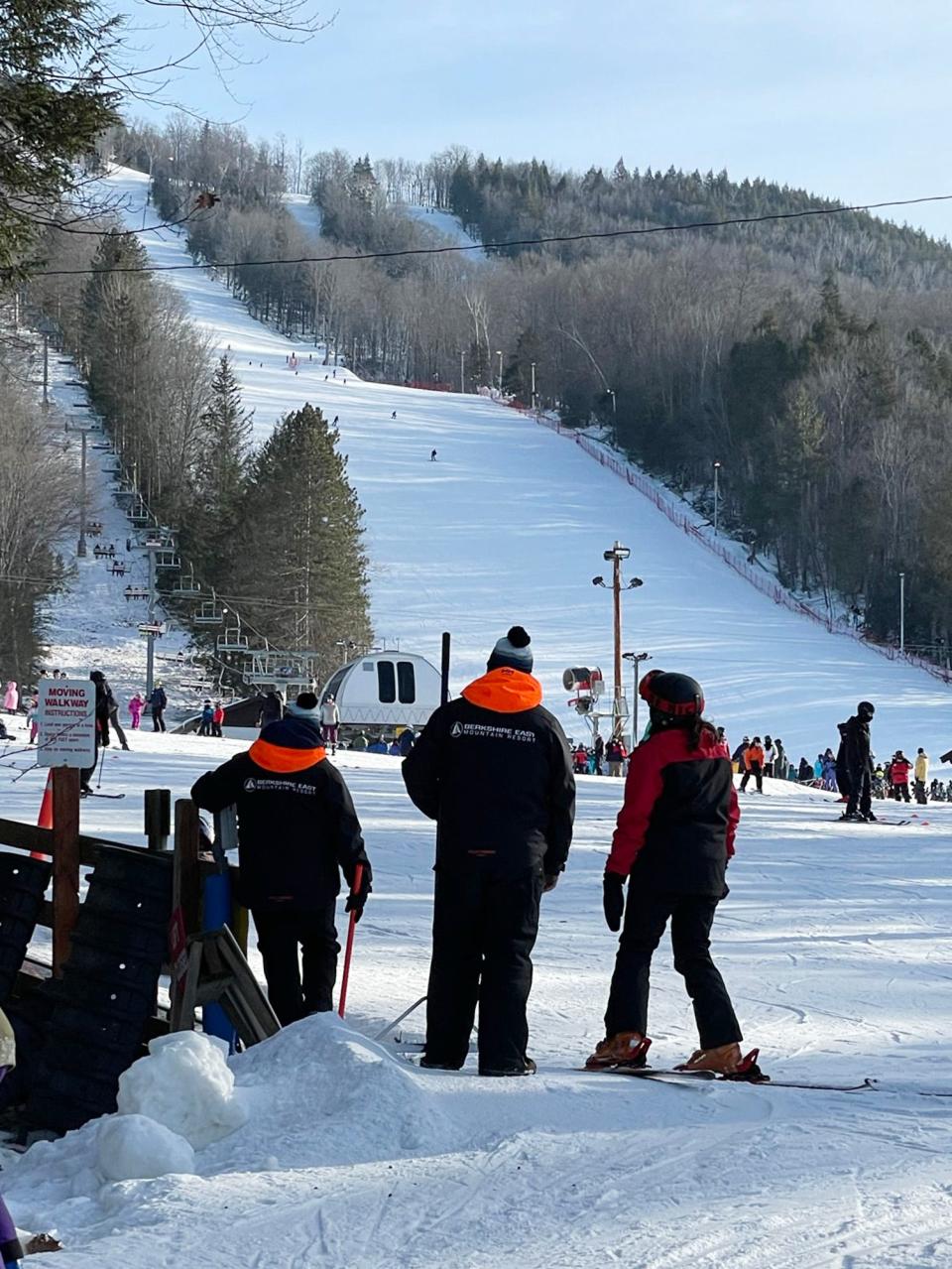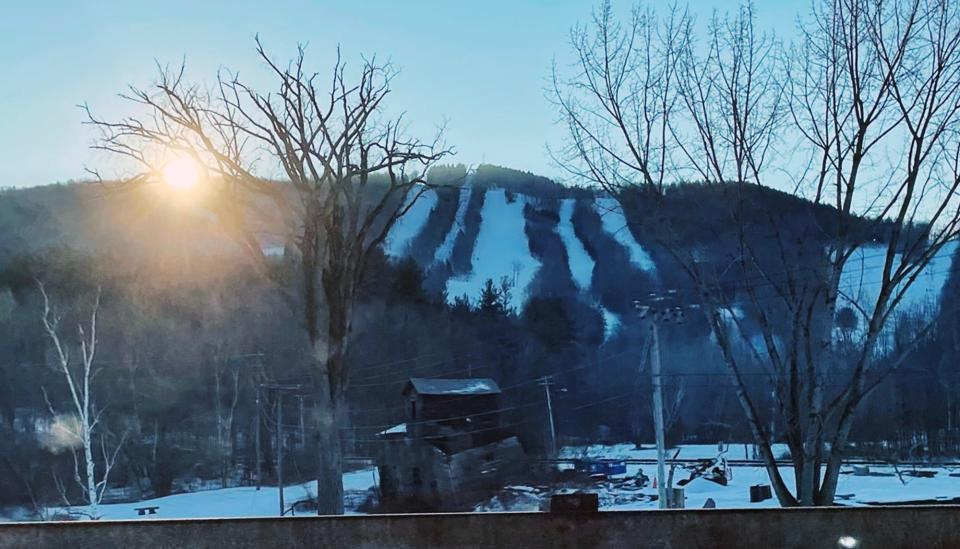Snow sports: Owner explains tough Sunday at Western Mass. ski areas

At ski areas, like at many complex operations, things go right until they don’t.
Take Berkshire East, the Charlemont mountain that has seen lots of growth in popularity and improvements in recent years, as a case in point.
General manager and co-owner Jon Schaefer, a direct kind of guy, characteristically came forward with a full explanation after a bad Sunday in the heart of the big Martin Luther King Jr. weekend last week, both at Berkshire East and Catamount, the Egremont ski area the Schaefer family bought in 2018.
Upfront about problems
Schaefer, who also is the Catamount GM, posted his account of the lift and snowmaking problems at both mountains on Catamount’s Facebook page.
I was at Berkshire East on Sunday. Conditions were good hardpack with decent terrain open, even though it was on all machine-made snow. But I was shocked at the long lift line that developed on the summit quad, snaking past the lodge and family cabanas that were installed last season.
I’ve skied Berkshire East regularly for years, attracted by its slew of plunging steep runs and laid-back vibe, and I’ve never seen it this packed, including during last year season’s first COVID-19 go-round. The independent Western Massachusetts ski area long has been an uncrowded oasis.
One big problem on this day, as Schaefer detailed in his post, was that the fuel for the backup summit triple diesel generator jelled up due to the deep sub-zero cold overnight and didn’t warm up enough to get the lift started until about noon. Once it started spinning, it relieved some of the pressure on the quad.
In the meantime, workers installed a new tank heating system to hopefully prevent this kind of thing in the future.
At the same time, the Wilderness Quad lift on the west side of the ski area stopped, stranding passengers on this cold day for as long as 40 minutes. The problem, Schaefer said, was a bad circuit card, which was replaced, and the lift resumed normal operations.
“The heater blew on the diesel for chair 1, that doesn’t happen when its normal winter … only when it’s really cold and busy,” Schaefer said sardonically.
Controlling crowding
Last season, Schaefer created a statistical model to predict the number of visits by season passholders versus day-ticket buyers, and it turned out Sunday’s passholder numbers were higher than usual, he said.
“It was an outlier,” he said. “I will pay attention to it going forward and adjust ticket sales accordingly.”
Berkshire East, like Wachusett Mountain in Princeton, limits capacity on the busiest days.
“We do have trip wires in place for tickets, not passes, and we don’t control our passholders,” Schaefer added. “On the lift front, we have invested a lot in new equipment, parts, added staff. I am fully confident in the system. However, (stuff) happens. Usually at the worst time.”

I’d also note that Berkshire East has seen increased traffic from Indy Pass holders last season and this season. The cheap pass includes two days each at Berkshire East and Catamount, along with 11 other New England ski areas.
Catamount’s challenges
As for Catamount, which straddles the New York border in far southwestern Massachusetts, the ski area has grown explosively since the Schaefers took over four years ago.
The ski area has become somewhat of a “Vermont south” destination for New York, New Jersey and Connecticut skiers and riders who have discovered the place.
Meanwhile, the Schaefers have cut five great new trails, built a new base lodge and put up new lifts, which is where some of Catamount’s problems have stemmed from with delays in replacing a 60-year-old double chair up the middle of the mountain.
Also, a replacement triple and quad that had been expected to go on line in 2001 still haven’t been completed. Schaefer said the triple will be ready for next season, and the quad, if not finished this year, also will be open for next season, and together should reduce lift lines dramatically.
Another huge headache has been Catamount’s snowmaking system. It has been plagued by problems this season, just as some of Colorado ski area chain Vail Resorts’ New England ski areas and others have been during a dry 2021-22 season that has depended almost solely on snowmaking.
In Catamount’s case, its electrical system was undersized, Schaefer wrote in his post, and so he decided to essentially rebuild it. Then arts delays led to power being restored to the New York side of the mountain just before the Christmas holidays — too late to get much terrain coverage for the vacation period.
“With the restored power, our booster pumps came back to life, and so did the NY snowmaking system,” Schaefer wrote. “The snowmaking system has been a challenge this year. We have installed miles of pipelines since purchasing Catamount, and in hindsight, maybe we should have replaced a few more miles.”
But more problems were to come during an ice storm a couple of Sundays ago that triggered a ruptured water line and on-hill power outage and frozen snowmaking guns and pipes — all in the midst of a COVID staffing shortage.
These challenges have been especially difficult for an independent ski area owner that has tried to do most of the infrastructure work itself.
“Some mountains choose to plug the holes, bury the problems and try to extend the lifespan of the business by making modest capital improvements in stopgap fashion,” Schaefer wrote. “We don’t do that. Berkshire East has had a steady investment over a 14-year period, and so its progression has been less jerky than Catamount, which is catching up in a three-year period, but we are getting the work done.”
Attitash and Wildcat still struggling
By comparison, Vail Resorts — with more capital at its disposal than Berkshire East — has also tried to improve the snowmaking systems at Attitash and Wildcat in New Hampshire, but it has not been nearly enough.
As of early this week, Attitash had only 31 percent of its terrain open, and Wildcat, 45 percent — even after the recent round of natural snow.
Meanwhile, Berkshire East had 93 percent of its terrain open after the Martin Luther King Jr. weekend snow and Catamount, just under 50 percent.
And at family-owned Wachusett, with its advanced, modern snowmaking system, 103 of 120 acres — or about 85 percent of the mountain — were ski-able as of this week.
—Contact Shaun Sutner by e-mail at s_sutner@yahoo.com.
This article originally appeared on Telegram & Gazette: Owner explains tough Sunday at Western Mass. ski areas

